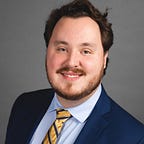Five Former Wilmington Mayors You Should Know About
It’s an odd numbered year, which means that we have a municipal election on the horizon this November. Members of municipal governments like Wilmington’s City Council will be up for election. The Mayor of Wilmington, who appears on the ballot every two years, will also be up for re-election.
Our current Mayor, Bill Saffo, was elected in 2007 and has won re-election ever since, making him the longest serving mayor in Wilmington’s long history. This year his challenger, former NC Senator Harper Peterson, also served as Mayor from 2001 to 2003. Given this year’s Battle of the Mayors, I wanted to reflect on some of the most extraordinary and influential mayors that we have had in the City of Wilmington, including some who are not well known today. Each of them has a fascinating story which paints a broader picture of the Wilmington that was.
- Dan Cameron (1955–1957)
Army Major Dan Cameron was 23 years old when word reached him in Normandy that his father, Bruce B. Cameron, the Mayor of Wilmington, had died suddenly of a stroke. That winter, Cameron would cross the Rhine into the Ardennes with the 430th Battalion, and find himself entrenched in the Battle of the Bulge.
When he returned home to Wrightsville Beach, he was encouraged by many to run for office as is father had. In 1952, he ran for Wilmington City Council and won. Two years later, at the age of 32, Cameron became the youngest Wilmington Mayor in history when the council elected him unanimously for that role.
One week before Christmas in 1955, the Atlantic Coastline Railroad, which at the time was the largest employer in town, announced that it would be leaving Wilmington permanently. Along with other leaders, Cameron began the Committee of 100; a group committed to bringing industry and jobs to the Cape Fear region, which was ultimately responsible for heralding companies like Corning Glass, DuPont, Hercules, and General Electric to the Wilmington area. Cameron was also one of the developers of Figure 8 Island, along with his cousin Raiford Trask.
The bridge on I-140 that crosses the Cape Fear River is named in his honor.
- Silas P. Wright (1897–1898)
Elected by the Wilmington City Council in 1897 (a practice that remained until the late 20th century,) Silas P. Wright was forced by gunpoint to resign during the massacre of 1898, along with a few other elected officials. In the only successful coup d’etat in American history, Wright was replaced by Col. Alfred Moore Waddell; a white supremacist and 1898 ringleader who would serve as mayor until 1905.
- J.E.L “Hi Buddy” Wade (1949–1950, 1958–1960)
James E.L. Wade served two terms as Wilmington mayor, first at the tail end of the 1940s, and later after fellow council member Dan Cameron’s term in 1958. A commissioner of public works in the 1930s, Wade played a role in getting money from the Public Works Administration for the renovations for Thalian Hall, and for creating the 20th century Wilmington phenomenon, the World’s Largest Christmas Tree. The same organization was responsible for creating Legion Stadium on Carolina Beach Road. The James Wade Scholarships at UNCW are named in honor of Wade.
- Moses John DeRosset (1766–1767)
Dr. Moses John DeRosset was a Medical Doctor and a “spirited citizen,” in the words of James Sprunt. He served as an officer in the French and Indian war in Virginia. When he returned home, he was active in local politics, serving on the City Commission with Wilmington’s first mayor, John Sampson (Mayors were then referred to as “His Worshipfulness”). In 1766, DeRosset was elected Mayor. He was a part of the resistance movement that opposed the stamp tax in what would eventually become the American Revolution. Unfortunately, Dr. DeRosset died in office on Christmas Day 1767, two days before his 41st birthday.
Today, The City Club is now housed in the historic DeRosset House on 2nd St.
DeRosset’s son, Armand DeRosset, became the state’s first licensed M.D.
- B.D. Schwartz (1971–1972)
A first generation Polish immigrant, B.D. Schwartz came to the United States at four years old along with his parents, who had started a furniture company in Wilmington, which Schwartz continued with after he graduated from UNC.
Schwartz was elected Mayor during a time of critical social unrest in Wilmington as the fight for civil rights played out in the streets and in the courtrooms of New Hanover County.
Schwartz later went on to serve in the NC House from 1972–1978 and in the NC Senate from 1978–1980, where he helped to establish centers for Autistic children in Wilmington, Asheville, and Charlotte.
Schwartz served on the Wilmington College Board of Trustees from 1958–1969 and was instrumental in finding and purchasing the land that UNCW is on today on S. College Road. Later when it became UNC Wilmington, he sat one the Board of Trustees again from 1981–1989. Schwartz Hall at UNCW is named in his honor.
His brother, Bill Schwartz, was elected to serve on the City Council in 1975, and served one term as Mayor in 1983.
